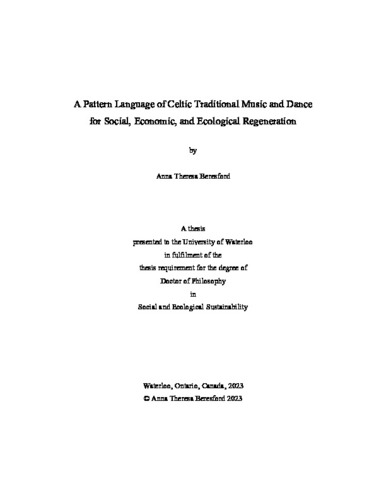| dc.description.abstract | This thesis investigates the potential role of Celtic traditional music and dance (CTMD) cultures in creating more resilient, embedded, and sustainable societies and economies. It does so by synthesising the ideas of the vernacular architect Christopher Alexander and an ecological form of political economy derived from the work of Karl Polanyi. With an empirical emphasis on a historically connected diaspora of the North Atlantic, the study explores the development and place-making potential of CTMD for marginalized communities exposed to the vagaries of global markets. Grounded in distributist economic theory, drawing heavily on Polanyian (‘substantivist’) economics, inspired in-part by anarchist visions of decentralization and sufficiency, the analysis starts from a historical sociological approach to capitalist modernity (Weber, Marx, Elias, Bauman). Challenging the conventional opposition of individualism versus collectivism, both state and market are seen as both interdependent and dependent on an anthropology of autonomous, transacting, ‘billiard-ball individuals’. For the purposes of this dissertation, and with a view to resilient local development, the counterpoint for all permutations of the State-Market is better understood in terms of the Polanyian category of ‘livelihood’. From this perspective, any transition to a sustainable modernity requires the re-emergence of more bottom-up, communitarian, and localized networks of families and place-based communities. Such a partial re-embedding of social and economic life would be predicated upon increased levels of trust and reciprocity, mutual obligation, community engagement, and informal markets and market places. Although the effects of capitalist modernization are sweeping, influencing all areas of life from the structure of whole societies to our very conception of self, there do still exist vestiges of pre-modern, place-based societies. In A Pattern Language, ecological architect, Christopher Alexander, documented the 253 replicable architectural patterns that create gestalt beauty and harmony in buildings. In this investigation, CTMD is explored as a vernacular culture that emerges in the same way, from repeated and nested patterns. A musical style based on the fiddle (but including many instruments such as pipes, accordion, piano, etc.) CTMD grew out of the folk cultures of France, the British Isles, and Northern Europe. In Canada especially, it has had considerable exchange and influence with First Nations and Métis cultures. Starting from this premise, the thesis applies pattern language theory to CTMD cultures and social networks and associations on both sides of the Atlantic. Through 72 interviews with 81 musicians, music teachers and students, parents, festival organizers, persons in economic development and place-marketing, i.e., the wide array of stakeholders in Celtic traditional music and dance cultures, it elucidates the social, political, and economic emergent patterns that are present in thriving CTMD cultures which constitute a ‘pattern language of Celtic traditional music and dance’. On the basis of this analysis it is argued that the application of pattern language theory to CTMD provides a useful framework through which to analyse human networks and to establish a framework for societies with higher numbers of grassroots networks and associations, and in doing so offers a hopeful means for increasing social, economic, and ecological resilience in marginalized areas particularly in the North Atlantic. Furthermore, it argues that this ‘pattern language of Celtic traditional music and dance’ provides a glimpse of what a new, more sustainable, ecologically benign and partially re-embedded modernity might look like as well as a framework by which to nudge society in that direction. | en |

